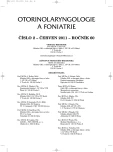Branchio–Oto–Renal Syndrome
Authors:
L. Školoudík 1; D. Kalfeřt 1; J. Růžička 1; J. Kopřiva 2
Authors‘ workplace:
Klinika ušní, nosní a krční LF UK a FN, Hradec Králové
; přednosta prof. MUDr. V. Chrobok, CSc., Ph. D.
Radiologická klinika LF UK a FN, Hradec Králové
1; přednosta prof. MUDr. P. Eliáš, CSc.
2
Published in:
Otorinolaryngol Foniatr, 60, 2011, No. 2, pp. 99-102.
Category:
Case Reports
Overview
Branchio-oto-renal syndrome is a disease characterized by branchial malformations, anomalies of external, middle or internal ear and kidney damage. The disease inheritance is autosomal dominant with very variable expressivity in clinical picture even in a single family.
The authors present a case report of a mother and child with different expressivity of clinical picture. The mother fulfils the criteria of branchio-oto-renal syndrome, the child that of the branchio-oto syndrome. The diagnosis of the disease was established on the basis of a clinical examination. The genetic analysis of this syndrome is not available in the Czech Republic. The diagnosis of the mother was established at her adult age, when the ear defect was searched for and bilateral partial hearing loss was determined. Based on the family anamnesis the authors searched specifically for ear and kidney damage, which made it possible to detect the hearing loss in the child and compensate the insufficiency with a hearing aid.
Key words:
branchio-oto-renal syndrome branchio-oto syndrome, genetic examination.
Sources
1. De Caluwé, D., Hayes, R., McDermott, M., Corbally, M. T.: Complex Branchial Fistula: A variant arch anomaly. J. Pediatr. Surg., 36, 2001, s. 1087-1088.
2. Fraser, F. C., Sproule, j.r., Halal, F.: Frequency of the branchio-oto-renal (BOR) syndrome in children with profound hearing loss. Am. J. Med. Genet., 7, 1980, s. 341-349.
3. Chang, E. H., Menezes, J. R., Meyer, N. C. et al.: Branchio-oto.renal syndrome: the mutation spectrum in EYA1 and its phenotypic consequences. Hum. Mutat., 23, 2004, s. 582-589.
4. Chen, A., Francis, M., Ni, L. et al.: Phenotypic manifestation of branchio-oto-renal syndrome. Am. J. Med. Genet., 58, 1995, s. 365-377.
5. Kochhar, A., Orten, D. J., Sorensen J. L. et al.: SIX1 mutation screening in 247 branchio-oto-renal syndrome families: a recurent missense mutation associated with BOR. Hum. Mutat., 29, 2008, s. 565.
6. Kemperman, M. H., Koch, S. M., Joosten, F. B., Kumar, S., Hyugen, P. L., Cremers C. W.: Inner ear anomalies are frequent but nonobligatory features of the branchio-oto-renal syndrome. Arch. Otolaryngol. Head Neck Surg., 128, 2002, s.1033-1038.
7. Keyvan, N., Ginger, R., Jaecklin, T., Pope, H. G., Dulguerov, P.: Management of congenital third branchial arch anomalies: A systematic review. Otolaryngol. Head Neck Surg., 142, 2010, s. 21-28.
8. Melnick, M., Bixler, D., Nance, W., Dilk, K., Yune, H.: Familiar branchio-oto-renal dysplasia: a new addition to the branchial arch syndromes. Clin. Genet., 9, 1976: s. 25-34.
9. Morisada, N., Rendtorff, N. D., Nozu, K. at al.: Branchio-oto-renal syndrome caused by partial EYA1 deletion due to LINE-1 insertion. Pediatr. Nephrol., 25, 2010, s. 1343-1348.
10. Okada, M., Fujimaru, R., Morimoto, N., Satomura, K., Kaku, Y, Tsuzuki, K., Nozu, K., Okuyama, T., Iijima, K.: EYA1 and SIX1 gene mutations in Japanede patients with branchio-oto-renal syndrome and related conditions. Pediatr. Nephrol., 21, 2006, s. 475-481.
11. Pellant , A., Pellantová, Z., Frank, M.: Příspěvek k hereditárním nefropatiím II. Nedoslýchavost v dětském věku. Českosl. Otolaryngol., 36, 1987, 6, s. 335-339.
12. Ruf, R. G., Xu, P. X. Silvius, D. et al.: SIX1 mutations cause branchio-oto-renal syndrome by dysruption of EYA1-SIX1-DNA complexes. Proc. Natl. Acad. Sci. USA, 101, 2004, s. 8090-8095.
Labels
Audiology Paediatric ENT ENT (Otorhinolaryngology)Article was published in
Otorhinolaryngology and Phoniatrics

2011 Issue 2
Most read in this issue
- Changes in Communication are the Biggest Handicap in Patients with Permanent Tracheostomy
- Extraesophageal Reflux Disease – Interdisciplinary Consensus
- Pendred Syndrome in the Czech Republic
-
Tumour Thrombosis of Internal Jugular Vein
A Case Report and Overview of Its Epidemiologic, Pathogenetic and Clinical Aspects
